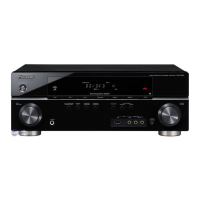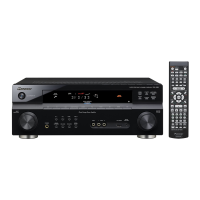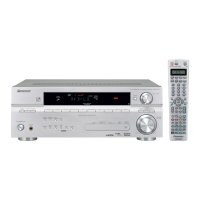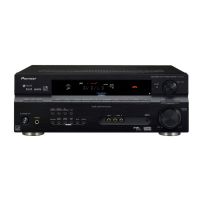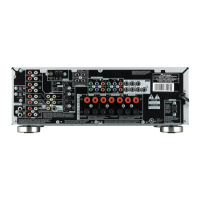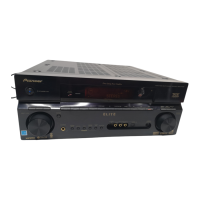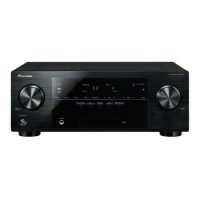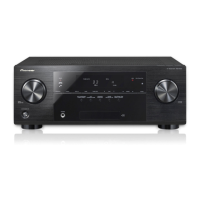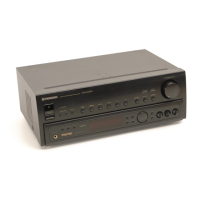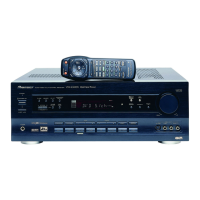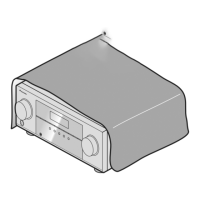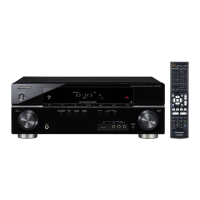
Do you have a question about the Pioneer VSX-819H-K and is the answer not in the manual?
| Impedance | 6 Ω |
|---|---|
| Audio output channels | 5.1 channels |
| Signal-to-Noise Ratio (SNR) | 98 dB |
| Audio system | Dolby TrueHD, DTS-HD Master Audio |
| Output power | 130 W |
| Dimensions (WxDxH) | 420 x 347.7 x 158 mm |
| Power requirements | 220 — 230 V, 50/60 Hz |
| Connectivity technology | Wired |
| Headphone connectivity | 3.5 mm |
| Digital audio optical out | 1 |
| Product color | Black |
| Power consumption (standby) | 0.65 W |
| Power consumption (typical) | 265 W |
| Weight | 9000 g |
|---|
Details on preventing electric shock by not opening the unit and referring servicing to qualified personnel.
Covers waterproofing, placement, ventilation, and fire hazards like naked flames.
Specifies temperature, humidity, and ventilation requirements for optimal operation.
Product is for household use; non-household use may void warranty.
Instructions on safe AC plug usage and disconnecting the unit when not in use.
Mentions Dolby and DTS trademarks and licensing information.
Lists supplied accessories included with the receiver for initial setup.
Instructions for battery installation and receiver placement for optimal performance.
Guidelines for safely installing the receiver, ensuring adequate ventilation to prevent overheating.
Explains the concept of home theater and surround sound effects.
Guides through connecting sources, speakers, and using the MCACC setup for surround sound.
Step-by-step instructions for connecting the microphone and initiating the Auto MCACC setup.
Highlights key points and warnings regarding the MCACC setup process for optimal results.
Details on following on-screen prompts, confirming speaker configuration, and waiting for test tones.
Instructions on confirming the setup, handling potential errors, and understanding the completion of the Auto MCACC process.
Addresses common issues and solutions when using the Auto MCACC setup for optimal room acoustics.
Explains the Phase Control feature for improving bass response and sound clarity.
Provides essential advice on connecting cables, including power off and avoiding cable bending.
Details HDMI cable usage, its capabilities, and compatibility with various digital audio/video formats.
Explains how to connect analog RCA and digital coaxial/optical audio cables.
Covers standard RCA video and component video cables for picture quality.
Guides on connecting a Blu-ray/DVD player via HDMI or other digital/analog outputs to the receiver.
Details how to connect the receiver's output to a TV using HDMI or standard video connections.
Explains connecting TV audio and multichannel analog outputs from sources like DVD Audio.
Details how to connect for analog recording from BD/DVD players.
Instructions for connecting a satellite receiver or digital set-top box using HDMI or digital audio.
Guides on connecting analog audio and video outputs from set-top boxes.
How to connect components with digital outputs, like CD recorders or MD players.
Instructions for connecting analog audio outputs for recording purposes.
Guides on connecting HDD/DVD recorders, VCRs via HDMI or digital audio inputs.
Details on connecting analog audio and video for recorders and VCRs.
How to connect source component video outputs to the receiver's inputs.
Instructions for assigning component video inputs in the system setup for correct signal recognition.
Accessing and connecting devices to the front panel audio/video input terminals.
Guides on connecting the supplied AM loop and FM wire antennas for radio reception.
How to connect an external FM antenna for improved reception quality.
Using vinyl-coated wire for an external AM antenna to enhance AM reception.
Detailed instructions for connecting various speaker configurations, including subwoofer and surround speakers.
Information on compatible speaker impedance and using speaker system B for multi-room audio.
Proper methods for connecting bare speaker wire to terminals for secure and safe connections.
Instructions on using PRE OUT outputs to connect an external amplifier for surround back speakers.
Recommendations for positioning speakers to achieve the best surround sound experience.
Diagrams illustrating optimal speaker placement for 5.1, 6.1, and 7.1 channel surround sound systems.
How to switch between SPA, SPB, and SP>AB speaker system settings.
Instructions for connecting an optional IR receiver for extended remote control functionality.
Critical safety instructions for handling the power cord and plugging the receiver into an outlet.
Identifies and describes key front panel controls like STANDBY/ON, INPUT SELECTOR, and TUNER buttons.
Explains buttons for listening modes (AUTO SURROUND, STEREO) and indicators like MCACC.
Details controls for advanced surround modes, multi-zone features, and iPod/USB inputs.
Specifies optimal conditions and limitations for remote control functionality.
Explains indicators like PHASE, AUTO, ST, TUNE, ZONE, Speaker, and Preset indicators.
Details indicators for detected audio formats such as DTS, HD, ES, 96/24, NEO:6, and Dolby Digital.
Explains indicators for Dolby Digital Plus, TrueHD, EX, Pro Logic, and DTS formats.
Covers indicators for signal selection (DIGITAL, HDMI) and playback modes (UP MIX, DIRECT).
Details buttons for input selection, receiver power, multi-control, and listening modes.
Explains buttons for dimmer, signal selection, playback modes, and basic navigation.
Buttons for accessing System Setup, Audio Parameters, and navigating menus.
Remote functions for controlling connected components and tuner operations.
Explains number buttons, source selection, and specific component control buttons like HDD/DVD/VCR.
Details controls for volume, mute, display information, and the SHIFT function for advanced operations.
How the receiver automatically selects playback modes based on the audio source.
Explains listening in surround sound with Dolby Digital, DTS, and various stereo surround modes.
Details various Dolby and DTS surround formats for multichannel and stereo sources.
Explores specific advanced surround effects like ACTION, DRAMA, and CLASSICAL for different content types.
How to listen in stereo and use Auto Level Control (A.L.C.) for consistent playback levels.
Utilizing Front Stage Surround Advance for enhanced sound using only front speakers.
Using Stream Direct for pure audio reproduction and Sound Retriever to restore compressed audio quality.
Utilizing Acoustic Calibration EQ and surround back channel processing for optimized sound.
Explains how the Up Mix function enhances surround sound by mixing surround and back channels.
Step-by-step guide on how to enable or disable the Up Mix feature for 7.1 channel systems.
Introduction to the AUDIO PARAMETER menu for adjusting sound settings like EQ and delay.
Details on EQ, Sound Delay, Midnight, Loudness, Sound Retriever, and Dual Mono settings.
Options for Dynamic Range Control (DRC) and LFE Attenuation for optimizing audio output.
Settings for HDMI audio routing, auto delay correction, and center/dimension adjustments.
How to select input signals and play audio/video from different sources.
Connecting multichannel analog inputs and using headphones with the receiver.
Introduction to the System Setup menu for configuring receiver functions and speaker settings.
Detailed instructions for manually setting speaker size, distance, and levels for optimal sound.
Specifying speaker sizes (SMALL/LARGE/NO) for accurate bass frequency routing.
Setting the crossover frequency to determine bass distribution between speakers and subwoofer.
Configuring subwoofer output and surround back speaker settings.
Setting crossover frequency and adjusting individual channel levels for sound balance.
Manually adjusting channel levels and specifying speaker distances for precise sound staging.
Setting up input assignments for components connected via component video cables.
Step-by-step guide to assigning component video inputs to specific sources like BD, TV, or DVR.
Overview of the multi-zone feature allowing audio in a second room.
How to set up Zone 2 by connecting an amplifier and speakers for a separate audio zone.
Steps for selecting sources and controlling the sub zone using front panel controls.
Using the remote control to operate the multi-zone features and power.
Methods for tuning into FM and AM radio stations, including automatic and manual tuning.
How to save favorite radio stations as presets for easy recall.
Recalling saved station presets and naming them for easier identification.
Changing the tuning step for better reception in different regions.
Steps for making audio or video recordings from various sources like tuner or connected components.
Ensuring correct connections and preparing the recording device and source for quality recordings.
How to program the remote to control other AV components using manufacturer codes.
Procedure for clearing all remote control presets and restoring factory defaults.
Explains the functions of TV-specific buttons like TV CONTROL, SOURCE, and MENU.
Details buttons for controlling BD/DVD players, cassette decks, and VCRs via the remote.
Functions for displaying information, accessing menus, and navigating BD/DVD options.
How to switch control modes for HDD, DVD, and VCR components.
A comprehensive list of preset codes for various DVD player manufacturers.
A list of preset codes for numerous television manufacturers.
An extensive list of preset codes for many television manufacturers.
Further manufacturer codes for televisions, covering a wide range of brands.
A list of preset codes for various VCR manufacturers.
Information on connecting an iPod to the receiver for audio playback control.
Step-by-step guide for connecting an iPod to the receiver's dedicated terminal.
How to browse and play music from an iPod using the receiver's interface.
Explains the basic controls for playback, pause, skip, and repeat functions for iPods.
Instructions for viewing photos and videos from an iPod, noting limitations.
Explains 'Made for iPod' and 'Works with iPhone' certifications and Apple's responsibility.
How to connect a USB mass storage device for two-channel audio playback.
Details the basic playback controls for USB devices, including skip, repeat, and shuffle functions.
Lists compatible compressed audio formats like MP3, WMA, and AAC, including specifications.
Information on MPEG-4 AAC and WMA audio technologies and their playback on the receiver.
Solutions for issues like no power, sudden shutdown, and no sound output from selected functions.
Troubleshooting steps for no picture, no subwoofer sound, and problems with surround/center speakers.
Resolving problems with radio noise, station selection, and playback from cassette decks.
Addressing issues with DTS playback, setup errors, remote control operation, and display problems.
Solutions for problems like no picture, no sound, or OSD not appearing during HDMI connections.
Configuration tips for ensuring proper HDMI signal transmission through the receiver.
Explains common iPod error messages (ERR1, ERR2, ERR3) and their remedies.
Lists USB error messages (ERR1, ERR3, ERR4) and provides solutions for USB connection problems.
How to change TV format settings and reset the receiver to factory defaults.
Detailed specifications for audio, tuner, video, and digital I/O sections of the receiver.
Information on control terminals, power requirements, and unit dimensions.
Guidelines for safely cleaning the receiver's exterior surfaces.
